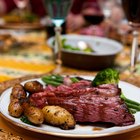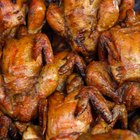Kondor83/iStock/GettyImages
Supermarkets often place a rotisserie oven filled with chickens in a prominent section of their deli, presenting a powerful visual and olfactory experience. The effect can be mesmerizing as the rotating birds bubble and turn deeply golden. Home rotisserie ovens offer the same even cooking and juicy results, with the added benefit of filling your home with enticing smells. They are typically compact countertop models, giving tasty roasted meals without overheating your kitchen.
Some Rotisserie Basics
For centuries, the most reliable way to cook a roast evenly was to impale it on a spit and turn it slowly in front of an open fire or bed of coals. The phrase "done to a turn" has come down from that era, implying that the food was cooked so perfectly that one rotation more or less would take away from the result. Modern electric rotisseries provide similarly even cooking, replacing the open fire with electric heating elements. They typically use a horizontal spit, though space-efficient models may use a vertical arrangement to minimize their use of counter space.
Loading a Large Cut
Large items such as a full-sized roast, chicken or small turkey must be carefully centered on the spit to minimize wear on the rotisserie's motor. You can get a feeling for the meat's center of gravity by turning it in your hands a few times. Slide the main spit rod through the meat, as close to the center of gravity as you can manage, then use the secondary rods or forks to fix it rigidly in place. Your model may require you to truss your poultry or roasts tightly with cotton butcher's twine to make a compact shape that cooks evenly, or it may hold large cuts in a basket, rather than on a spit, so you don't need to pierce the meat and lose its juices.
Loading Skewers
Models often make provision for cooking smaller items, such as skewers of meat and vegetables. In some cases, special skewers are designed to fit a specific rotisserie and are then either sold with it or as optional accessories. In other instances the models use wire racks that clip into the rotisserie's frame and sandwich ordinary skewers between them. The small secondary forks or prongs used to stabilize large roasts on the spit can also be used to hold smaller foods, such as tiny Cornish game hens or slender pork tenderloins.
General Hints
Electric rotisseries vary widely in sophistication. Basic models may offer only High and Low heat settings, while more advanced models allow you to set timers and program specific temperatures. The recipes that accompany your rotisserie are usually tailored to its strengths, so use them as a guide for adapting recipes meant for conventional oven cooking. One quirk shared by almost all countertop rotisseries is that the cooking elements are very close to the food, so they can't be left unattended while they cook. There's always a risk of fat spatters igniting and causing a potentially nasty fire in your kitchen.
Related Articles

How to Rotisserie Cook Without a ...
How to Cook Prime Rib on an Electric ...

How to Cook a Roast Beef on a ...

Rotisserie Cooking Times
How to Cook Pork Chops in a Vertical ...

Does a Roaster Oven Cook Faster Than ...

How to Cook a Rotisserie Sirloin Tip ...

How to Cook Prime Rib Using an Oven ...

Tools Used in Food Processing

Can You Bake Sliders?
How to Cook With a Reverse Flow Smoker
How to Cook a Standing Rib Roast on a ...

How to Use a Probe Cooking Thermometer

How to Cook a Beef Roast Over an Open ...

How to Cook With the Sunbeam Rotisserie
How do I Cook a Prime Rib on an Open ...
How to Make Beef Bottom Round Roast ...
How to Cook a Center Cut Sirloin of ...

How to Grill a Ribeye on a Weber Q

How to Cook a Standing Rib With the ...
References
Writer Bio
Fred Decker is a trained chef and prolific freelance writer. In previous careers, he sold insurance and mutual funds, and was a longtime retailer. He was educated at Memorial University of Newfoundland and the Northern Alberta Institute of Technology. His articles have appeared on numerous home and garden sites including GoneOutdoors, TheNest and eHow.